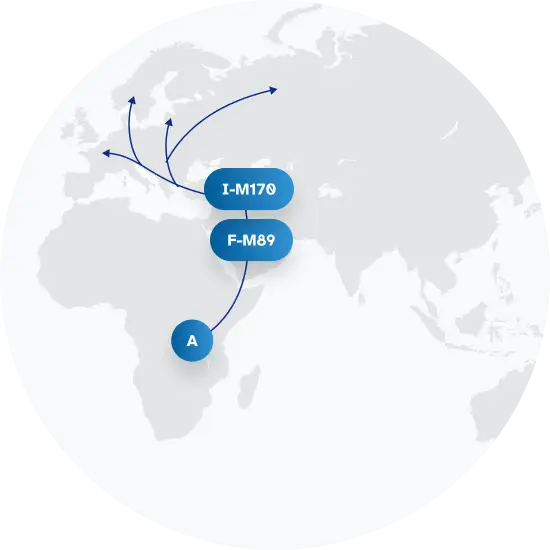Explore the Family Name Caban
How common is the last name Caban in the United States?
The surname Caban has seen a rise in popularity over the last decade, according to the Decennial U.S. Census data. In 2000, it ranked as the 6434th most popular surname in the United States with an estimated 4868 individuals bearing this name. By 2010, it had risen to the 5791st rank, with an increase of approximately 9.99% in popularity. The count of people with the surname also saw a significant growth of 22.72% from 4868 in 2000 to 5974 in 2010. Consequently, the proportion of the population with this surname per 100,000 also increased by 12.78%, from 1.8 in 2000 to 2.03 in 2010.
| 2000 | 2010 | Change | |
|---|---|---|---|
| Rank | #6,434 | #5,791 | 9.99% |
| Count | 4,868 | 5,974 | 22.72% |
| Proportion per 100k | 1.8 | 2.03 | 12.78% |
Race and Ethnicity of people with the last name Caban
In terms of ethnic identity, the data from the Decennial U.S. Census reveals interesting changes between 2000 and 2010. The majority of individuals with the Caban surname identified as Hispanic, with 83.36% in 2000 slightly decreasing to 82.12% in 2010. The percentage of those identifying as White rose by 12.21% during this period. Those identifying as Asian/Pacific Islander decreased from 2.36% to 2.14%. The Black community saw a decrease of 27.56% in individuals with the Caban surname. The category of "Two or more races" appeared in 2010 with 1.07%, and there was a small emergence of American Indian and Alaskan Native identification at 0.32% in 2010, which did not exist in 2000 data.
| 2000 | 2010 | Change | |
|---|---|---|---|
| Hispanic | 83.36% | 82.12% | -1.49% |
| White | 11.96% | 13.42% | 12.21% |
| Asian/Pacific Islander | 2.36% | 2.14% | -9.32% |
| Two or More Races | 0% | 1.07% | 0% |
| Black | 1.27% | 0.92% | -27.56% |
| American Indian and Alaskan Native | 0% | 0.32% | 0% |
Caban ancestry composition
23andMe computes an ancestry breakdown for each customer. People may have ancestry from just one population or they may have ancestry from several populations. The most commonly-observed ancestry found in people with the surname Caban is Spanish & Portuguese, which comprises 49.9% of all ancestry found in people with the surname. The next two most common ancestries are Indigenous American (12.2%) and British & Irish (9.8%). Additional ancestries include French & German, Eastern European, Senegambian & Guinean, Italian, and Nigerian.
Ready to learn more about your ancestry? Get the most comprehensive ancestry breakdown on the market by taking our DNA test. Shop 23andMe
| ANCESTRY BREAKDOWN | COMPOSITION |
|---|---|
| Spanish & Portuguese | 49.9% |
| Indigenous American | 12.2% |
| British & Irish | 9.8% |
| Other | 28.1% |

Possible origins of the surname Caban
Your DNA provides clues about where your recent ancestors may have lived. Having many distant relatives in the same location suggests that you may all share common ancestry there. Locations with many distant relatives can also be places where people have migrated recently, such as large cities. If a large number of individuals who share your surname have distant relatives in a specific area, it could indicate a connection between your surname and that location, stemming from either recent ancestral ties or migration.
Based on 23andMe data, people with last name Caban have recent ancestry locations all within Puerto Rico.
| RECENT ANCESTRY Location | Percentage |
|---|---|
| Isabela, Puerto Rico | 69.10% |
| Yauco, Puerto Rico | 69.10% |
| Mayaguez, Puerto Rico | 69.10% |
| Manati, Puerto Rico | 69.10% |
| Juncos, Puerto Rico | 69.10% |
What Caban haplogroups can tell you
Haplogroups are genetic population groups that share a common ancestor on either your paternal or maternal line. These paternal and maternal haplogroups shed light on your genetic ancestry and help tell the story of your family.
The top paternal haplogroup of people with the surname Caban is I-L1498, which is predominantly found among people with European ancestry. Haplogroup I-L1498 is descended from haplogroup I-M170. Other common haplogroups include I-L161.1 and R-L51, which are predominantly found among people with European and European ancestry. Other surnames with similar common haplogroups are: Nance, Burnside, Madigan, Carmody, Skelly, Flagg, Feeney, Haws, Morrissey, Wisner.
The most common maternal haplogroups of people with Caban surname are: A2, H1, C1. These most commonly trace back to individuals of European ancestry.
 Paternal Haplogroup Origins I-M170
Paternal Haplogroup Origins I-M170Your maternal lineage may be linked to some of the first Americans
Though the Ice Age was beginning to retreat when your A2 ancestors first entered North America, there were still massive barriers blocking their way. Glaciers and inhospitable climate covered much of the continent, blocking entry into the interior. Nonetheless, researchers have found evidence that a wave of American founders migrated over 13,000 kilometers to reach southern Chile in only 2,000 years, a blink of an eye in the story of human migration! Their highway to the south was the coast of the Pacific, stocked with fish, diverse marine mammals, and other valuable resources in the rich kelp forests of the upper latitudes and in the abundant fresh-water rivers near the equator. Because of this rapid movement south, the A2 haplogroup and its diverse branches are found throughout North and South America.

What do people with the surname Caban have in common?
Spoiler alert: it's complicated. People with the same last name are usually no more genetically similar than a randomly sampled group of people from the same population. That said, people with the same surname are more likely to have similar ancestries than randomly sampled individuals. The reason is the tendency of people with similar cultural or geographical backgrounds to preferentially mate with one another. That's why people who share a surname may be more likely to share traits and tendencies in common than people within the general population. Check out the percentages below to see the prevalences of tastes, habits, and traits of people with your surname compared with prevalences among 23andMe users.
Preferences
Traits

Cheek Dimples
Small indentations that appear on the cheeks when a person smiles.
"Caban" Surname 44.4%
23andMe Users 37.6%
Habits
Wellness

Migraine
A severe headache characterized by intense pain, sensitivity to light and sound, and often accompanied by nausea and vomiting.
"Caban" Surname 18.1%
23andMe Users 16.4%
Are health conditions linked to the last name Caban?
The short answer is that, if there is an association between surname and health, it's usually more about your ancestry than your name. Individuals with a given surname are no more genetically similar than the general population but often have similar ancestries. The populations of people associated with those shared ancestries often have sets of genetic variations, also known as alleles, in common. Some of those alleles are associated with a greater likelihood of developing certain diseases.
Disease variant frequency by ancestry
Disease allele frequencies in populations associated with the surname Caban are shown below. Important Note: not everyone with a disease allele will develop these health condition





